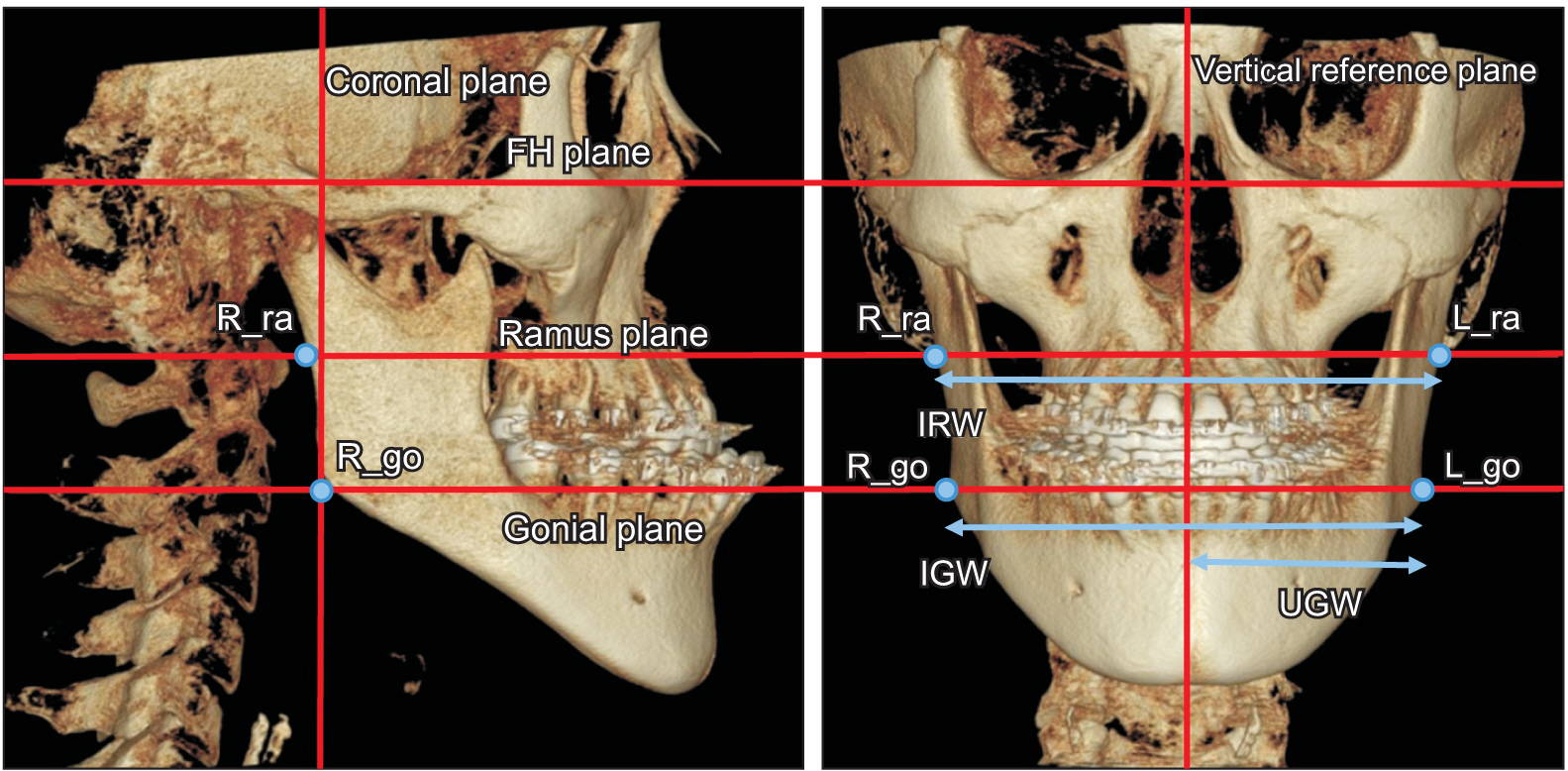Korean J Orthod.
2023 Mar;53(2):99-105. 10.4041/kjod22.077.
Three-dimensional evaluation of mandibular width after mandibular asymmetric setback surgery using sagittal split ramus osteotomy
- Affiliations
-
- 1Department of Orthodontics, Dental Research Institute, and Dental and Life Science Institute, School of Dentistry, Pusan National University, Yangsan, Korea
- KMID: 2540949
- DOI: http://doi.org/10.4041/kjod22.077
Abstract
Objective
The study aimed to evaluate the changes in mandibular width after sagittal split ramus osteotomy (SSRO) in patients with mandibular asymmetric prognathism using cone-beam computed tomography (CBCT).
Methods
Seventy patients who underwent SSRO for mandibular setback surgery were included in two groups, symmetric (n = 35) and asymmetric (n = 35), which were divided according to the differences in their right and left setback amounts. The mandibular width was evaluated three-dimensionally using CBCT images taken immediately before surgery (T1), 3 days after surgery (T2), and 6 months after surgery (T3). Repeated measures analysis of variance was applied to verify the differences in mandibular width statistically.
Results
Both groups showed a significant increase in the mandibular width at T2, followed by a significant decrease at T3. No significant difference was observed between T1 and T3 in any of the measurements. No significant differences were found between the two groups (p > 0.05). Conclusions: After mandibular asymmetric setback surgery using SSRO, the mandibular width increased immediately but returned to its original width 6 months after surgery.
Figure
Reference
-
1. Jang KS, Bayome M, Park JH, Park KH, Moon HB, Kook YA. 2017; A three-dimensional photogrammetric analysis of the facial esthetics of the Miss Korea pageant contestants. Korean J Orthod. 47:87–99. DOI: 10.4041/kjod.2017.47.2.87. PMID: 28337418. PMCID: PMC5359635.2. Kim SK, Han JJ, Kim JT. 2001; Classification and treatment of prominent mandibular angle. Aesthetic Plast Surg. 25:382–7. DOI: 10.1007/s002660010150. PMID: 11692255.3. Yang WS. 1995; The study on the orthodontic patients who visited Department of Orthodontics, Seoul National University Hospital during last 10 years (1985-1994). Korean J Orthod. 25:497–509.4. Bell WH. 1993. Modern practice in orthognathic and reconstructive surgery. 3rd ed. Saunders;Philadelphia: DOI: 10.1097/00006534-199308000-00030.5. Busby BR, Bailey LJ, Proffit WR, Phillips C, White RP Jr. 2002; Long-term stability of surgical class III treatment: a study of 5-year postsurgical results. Int J Adult Orthodon Orthognath Surg. 17:159–70. PMID: 12353934.6. Proffit WR, Phillips C, Dann C 4th, Turvey TA. 1991; Stability after surgical-orthodontic correction of skeletal Class III malocclusion. I. Mandibular setback. Int J Adult Orthodon Orthognath Surg. 6:7–18. PMID: 1940541.7. Choi HS, Rebellato J, Yoon HJ, Lund BA. 2005; Effect of mandibular setback via bilateral sagittal split ramus osteotomy on transverse displacement of the proximal segment. J Oral Maxillofac Surg. 63:908–16. DOI: 10.1016/j.joms.2004.06.064. PMID: 16003615.8. Choi WH, Kim JH, Park YW. 2003; A clinical study on the effects of bilateral sagittal split ramus osteotomy on the postoperative condylar positional changes in the mandibular prognathism. J Korean Assoc Maxillofac Plast Reconstr Surg. 25:525–32.9. Yoo JY, Kwon YD, Suh JH, Ko SJ, Lee B, Lee JW, et al. 2013; Transverse stability of the proximal segment after bilateral sagittal split ramus osteotomy for mandibular setback surgery. Int J Oral Maxillofac Surg. 42:994–1000. DOI: 10.1016/j.ijom.2013.01.021. PMID: 23538214.10. Yeo BR, Han JJ, Jung S, Park HJ, Oh HK, Kook MS. 2018; Horizontal changes of the proximal mandibular segment after mandibular setback surgery using 3-dimensional computed tomography data. Oral Surg Oral Med Oral Pathol Oral Radiol. 125:14–9. DOI: 10.1016/j.oooo.2017.07.002. PMID: 28958899.11. Lim SY, Jiang T, Oh MH, Kook MS, Cho JH, Hwang HS. 2017; Cone-beam computed tomography evaluation on the changes in condylar long axis according to asymmetric setback in sagittal split ramus osteotomy patients. Angle Orthod. 87:254–9. DOI: 10.2319/043016-349. PMID: 28253453. PMCID: PMC8384354.12. Song SH, Kim JY, Lee SH, Park JH, Jung HD, Jung YS. 2019; Three-dimensional analysis of transverse width of hard tissue and soft tissue after mandibular setback surgery using intraoral vertical ramus osteotomy: a retrospective study. J Oral Maxillofac Surg. 77:407.e1–6. DOI: 10.1016/j.joms.2018.10.008. PMID: 30439330.13. Ha SW, Kim SJ, Choi JY, Baek SH. 2022; Characterization of facial asymmetry phenotypes in adult patients with skeletal Class III malocclusion using three-dimensional computed tomography and cluster analysis. Korean J Orthod. 52:85–101. DOI: 10.4041/kjod.2022.52.2.85. PMID: 35321948. PMCID: PMC8964472.14. Cohen J. 1992; A power primer. Psychol Bull. 112:155–9. DOI: 10.1037/0033-2909.112.1.155. PMID: 19565683.15. Dal Pont G. 1961; Retromolar osteotomy for the correction of prognathism. J Oral Surg Anesth Hosp Dent Serv. 19:42–7.16. Frost D, Bays R, Marciani R, Betts N, Williams T, Powers M, et al. 2000. Oral and maxillofacial surgery. Saunders;Philadelphia: DOI: 10.1016/s0278-2391(00)80047-6.17. Pan JH, Lee JJ, Lin HY, Chen YJ, Jane Yao CC, Kok SH. 2013; Transverse and sagittal angulations of proximal segment after sagittal split and vertical ramus osteotomies and their influence on the stability of distal segment. J Formos Med Assoc. 112:244–52. DOI: 10.1016/j.jfma.2012.02.013. PMID: 23660219. PMID: fa7aa9c9cded405e9a93471b75d75f96.18. Kim JW, Son WS, Kim SS, Kim YI. 2015; Proximal segment changes after bilateral sagittal split ramus osteotomy in facial asymmetry patients. J Oral Maxillofac Surg. 73:1592–605. DOI: 10.1016/j.joms.2015.02.021. PMID: 25976689.19. Choi JH, Mah J. 2010; A new method for superimposition of CBCT volumes. J Clin Orthod. 44:303–12. PMID: 20831099.20. Kim KA, Lee JW, Park JH, Kim BH, Ahn HW, Kim SJ. 2017; Targeted presurgical decompensation in patients with yaw-dependent facial asymmetry. Korean J Orthod. 47:195–206. DOI: 10.4041/kjod.2017.47.3.195. PMID: 28523246. PMCID: PMC5432441.
- Full Text Links
- Actions
-
Cited
- CITED
-
- Close
- Share
- Similar articles
-
- A clinical study on the effects of bilateral sagittal split ramus osteotomy on the postoperative condylar positional changes in the mandibular prognathism
- Changes in gonial angle and mandibular width after orthognathic surgery in mandibular prognathic patients
- Comparative study of stability and relapse according to fixation method after bilateral sagittal split ramus osteotomies in mandibular prognathic patients
- Stability after Surgical Correction of Mandibular Prognathism Using Bilateral Sagittal Split Ramus Osteotomy with Rigid Fixation
- Analysis of short face tendency and it's determinant factors after bilateral sagittal split ramus osteotomy of mandibular prognathism




